Cham of the Bondons
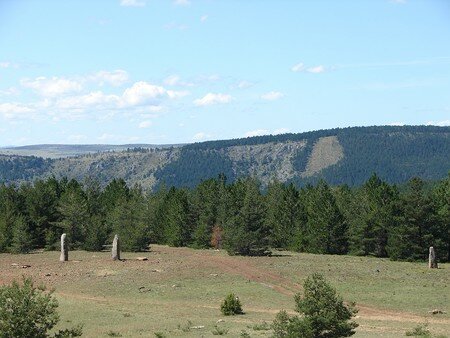 No comments before to have visited the following sites:
No comments before to have visited the following sites:
http://perso.orange.fr/deesse-mere/1menhir.htm
http://prehist.free.fr/bondons/
The first being closer to my vision of the things, the second having a more archaeological approach.
Us here thus in Cham of the Bungs….drawing its name from the occitano-patois Cham (plate or causse) and proximity of the commune of the Bungs in Lozere. It is a calcareous plate of ten square kilometres extending to the foot from the Lozere Mount.
 (Wikipédia):
With its 154 granite menhirs, the site constitutes the second
concentration of monuments megalithic in Europe after alignments of
Carnac in Brittany.
(Wikipédia):
With its 154 granite menhirs, the site constitutes the second
concentration of monuments megalithic in Europe after alignments of
Carnac in Brittany.
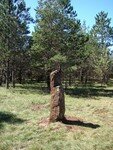 It is estimated that the installation of these stones must be between
the end of the Neolithic era and the age of Bronze. (Me I ask to see…
Nobody dared until now to give dates more in conformity with work of
radiesthesists, except a site presenting of the megaliths of Brittany
from which I lost the bond, and who proposed the -25.000 years…)
It is estimated that the installation of these stones must be between
the end of the Neolithic era and the age of Bronze. (Me I ask to see…
Nobody dared until now to give dates more in conformity with work of
radiesthesists, except a site presenting of the megaliths of Brittany
from which I lost the bond, and who proposed the -25.000 years…)
 This
site also conceals a geological curiosity: two nipples limestones
having resisted erosion and dominating the valley of the Tarn. These
puechs (of Latin podium, high ground), as they are called,
would be resulting according to the legend from the mud fallen from the
shoes from Gargantua. (It really everywhere is found this honest giant…)
This
site also conceals a geological curiosity: two nipples limestones
having resisted erosion and dominating the valley of the Tarn. These
puechs (of Latin podium, high ground), as they are called,
would be resulting according to the legend from the mud fallen from the
shoes from Gargantua. (It really everywhere is found this honest giant…)


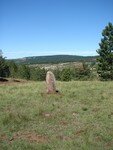 On
a surface of hardly 10 km ² were planted there is more than 4000 years
(Ca it is at least…) more than 150 menhirs. Certain researchers advance
the number of 154 and others beyond this figure. The first great
inventory of these monoliths goes back to the years 1940 with Doctor
Morel.
On
a surface of hardly 10 km ² were planted there is more than 4000 years
(Ca it is at least…) more than 150 menhirs. Certain researchers advance
the number of 154 and others beyond this figure. The first great
inventory of these monoliths goes back to the years 1940 with Doctor
Morel.
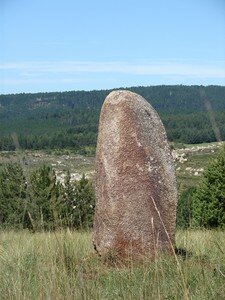
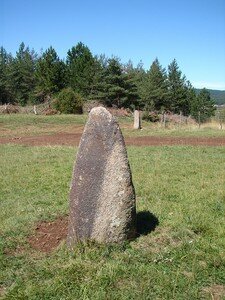 Since,
few or not publications on this site, if not confidential. Thanks to
the local authorities and the Service of Antiquities directed to Lozere
by Gilbert Fages, this inheritance is leaving the shade gradually.
(yes, it leaves the shade, and it is so much better… It's a pity that
the stones are not raised completely as they were planted.)
Since,
few or not publications on this site, if not confidential. Thanks to
the local authorities and the Service of Antiquities directed to Lozere
by Gilbert Fages, this inheritance is leaving the shade gradually.
(yes, it leaves the shade, and it is so much better… It's a pity that
the stones are not raised completely as they were planted.)
 Indeed, all at the beginning of the XX E
century, these was at most between 3 and 7 menhirs which were still
upright. In the years 1980-1990, about thirty stones had been raised.
Today, these are at least 80 menhirs which found the vertical.
Indeed, all at the beginning of the XX E
century, these was at most between 3 and 7 menhirs which were still
upright. In the years 1980-1990, about thirty stones had been raised.
Today, these are at least 80 menhirs which found the vertical.

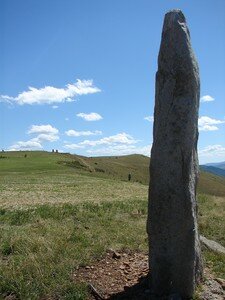 Among
the latter, one will note in the south of the hamlets of Vaissière and
Fare, two very large menhirs respectively measuring 4,80 m and 4,50 m
except ground. Still lying a few years ago but given today to the
vertical, they bordered 6 m length.
Among
the latter, one will note in the south of the hamlets of Vaissière and
Fare, two very large menhirs respectively measuring 4,80 m and 4,50 m
except ground. Still lying a few years ago but given today to the
vertical, they bordered 6 m length.
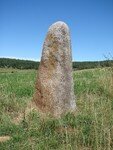


 Initially,
it is noticed that all the menhirs of this unit are out of granite
extracted the southern slopes of the solid mass of the Lozere Mount.
However, these stones were planted in entirely calcareous ground. They
were thus transported to be set up at this place at a distance minimum
of 800 Mr. For certain stones, the distance between the place of
extraction and the place of erection must amount in kilometers.
Initially,
it is noticed that all the menhirs of this unit are out of granite
extracted the southern slopes of the solid mass of the Lozere Mount.
However, these stones were planted in entirely calcareous ground. They
were thus transported to be set up at this place at a distance minimum
of 800 Mr. For certain stones, the distance between the place of
extraction and the place of erection must amount in kilometers.

 In
the second place, the menhirs do not seem not laid out in space in a
rational way. One finds a great number of menhirs alone, menhirs per
pairs and more rarely in line of three. Half-circles and vague circles
(cromlechs) take shape with the n°2 groups of Fage and the Hut of the
Air.
In
the second place, the menhirs do not seem not laid out in space in a
rational way. One finds a great number of menhirs alone, menhirs per
pairs and more rarely in line of three. Half-circles and vague circles
(cromlechs) take shape with the n°2 groups of Fage and the Hut of the
Air.
 There
are thus no here long alignments of the Carnac type in Brittany or
provisions in perfect circles as on Causse of Blandas (department of
Gard) the largest menhirs are often on hillocks but there still it is
not a general information.
There
are thus no here long alignments of the Carnac type in Brittany or
provisions in perfect circles as on Causse of Blandas (department of
Gard) the largest menhirs are often on hillocks but there still it is
not a general information.


 In
the third place and most prone to assumptions, it is of course to know
the motivation of the prehistoric manufacturers to raise as many stones
in such a restricted place. One thus spoke about ancient beaconings of
ways per time of strong snows, (I had not thought of that), of
indicating terminals of entries of mines, (either) stakes of a “road of
uranium” (to be seen)…
In
the third place and most prone to assumptions, it is of course to know
the motivation of the prehistoric manufacturers to raise as many stones
in such a restricted place. One thus spoke about ancient beaconings of
ways per time of strong snows, (I had not thought of that), of
indicating terminals of entries of mines, (either) stakes of a “road of
uranium” (to be seen)…
 Nothing
makes it possible today to support or refute completely such or such
assumptions. Nevertheless, one can advance the idea that these
monoliths drawn up per tens could have shown the strong religious
feeling and the power of a tribe on others. (why always want to mix the
religion with the megaliths… Except if one takes the word in his first
significance which is “to connect to”.)
Nothing
makes it possible today to support or refute completely such or such
assumptions. Nevertheless, one can advance the idea that these
monoliths drawn up per tens could have shown the strong religious
feeling and the power of a tribe on others. (why always want to mix the
religion with the megaliths… Except if one takes the word in his first
significance which is “to connect to”.)
Many are the legends arrived to us and who point out the capacity of fertility and force attached to the planted stones. (one approaches)
 In
planting as much on a few square kilometres was to cover a very
important religious symbolic system (still!!!) if not policy (if the
policy were interfered initiation with the earth currents…) and thus to
confer on Cham Bungs there is more than 4000 years the concept of
“crowned place”. What is sure today, it is that mysterious Cham of the
Bungs jealously keeps the mystery of the people which drew up these
monoliths directed towards the sky and their original function. Cham of
the Bungs, in addition to being the second more important concentration
French of menhirs after Carnac, is also a very pleasant place of
excursion very easy to explore and where Prehistory lozérienne and
Cevennes is revealed with each turning of ways. (Wikipédia)
In
planting as much on a few square kilometres was to cover a very
important religious symbolic system (still!!!) if not policy (if the
policy were interfered initiation with the earth currents…) and thus to
confer on Cham Bungs there is more than 4000 years the concept of
“crowned place”. What is sure today, it is that mysterious Cham of the
Bungs jealously keeps the mystery of the people which drew up these
monoliths directed towards the sky and their original function. Cham of
the Bungs, in addition to being the second more important concentration
French of menhirs after Carnac, is also a very pleasant place of
excursion very easy to explore and where Prehistory lozérienne and
Cevennes is revealed with each turning of ways. (Wikipédia)
Good, I make fun a little, but this article is very well made and has the merit to speak about one of the most extraordinary sites which I know. My photographs will have it to you, I hope for it, shown.
It is true that it is not any more very brilliant on the level of energies, but some places go very well still. Moreover, with each one its felt: there are as well raised stones, as any person must be able to find that which will make it vibrate…
And that of happiness to be able to touch the stones, the renifler, their speech, to leave his pendulum, to turn around, to cherish them, meditate, dance if the heart you of known as, without closed areas nor disfiguring crowd… I even thought of seeing, on a hill with far, several drawn up stones coast at coast: zoom X 24. Surprised…
Cham of the Bungs is composed of several groups of menhirs of size and variable interest:
The group of Fage, extremely of a score of laid down menhirs, merges in an afforestation and the monoliths are of average size (between 1,50 and 2,50 m). Because of its screening by the vegetation and of the relative smallness of the menhirs, the interest of this group is relatively low.
 The
n°2 group of Fage certainly more is known and more visited. It counts
more than one score of rectified menhirs, a dolmen and tumulus.
The
n°2 group of Fage certainly more is known and more visited. It counts
more than one score of rectified menhirs, a dolmen and tumulus.
 The
arranged carpark is established very close to the starting point of
this group and its menhir emblematic “Pierre of the Three Parishes”.
One easily recognizes this beautiful stone with the marks cut in the
rock left by tests of cutting up carried out by carriers. Formerly
slept, it would have to border 5,45 m length. It was partly cut down by
the carriers and today, once rectified, it culminates with less than 3
m height.
The
arranged carpark is established very close to the starting point of
this group and its menhir emblematic “Pierre of the Three Parishes”.
One easily recognizes this beautiful stone with the marks cut in the
rock left by tests of cutting up carried out by carriers. Formerly
slept, it would have to border 5,45 m length. It was partly cut down by
the carriers and today, once rectified, it culminates with less than 3
m height.
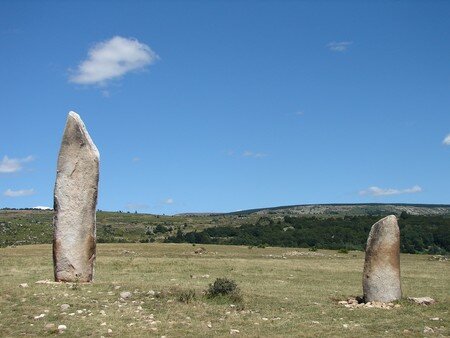 All
around this stone and while approaching the hamlet of Combettes
(downwards in the valley), one meets while following the GR. the dolmen
of Fage, some menhirs insulated and on a projecting ledge a little low,
the beautiful unit formed by the three aligned menhirs of Chabusses.
All
around this stone and while approaching the hamlet of Combettes
(downwards in the valley), one meets while following the GR. the dolmen
of Fage, some menhirs insulated and on a projecting ledge a little low,
the beautiful unit formed by the three aligned menhirs of Chabusses.

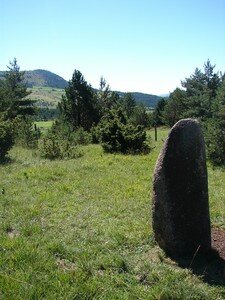 Once
crossed the small pine forest located just at side and while following
the GR., they are menhirs alone or by groups of two which await the
hikers and that until Combettes. While going towards the east starting
from “Pierre of the Three Parishes”, several pairs of menhirs were
replanted and that until the top of a nipple.
Once
crossed the small pine forest located just at side and while following
the GR., they are menhirs alone or by groups of two which await the
hikers and that until Combettes. While going towards the east starting
from “Pierre of the Three Parishes”, several pairs of menhirs were
replanted and that until the top of a nipple.
The group of the hut of the Air counts a score of menhirs whose average size ranges between 1,70 and 2 Mr. They for their great majority are established with the tops of small croups located at the south of the house known as of the Hut of the Air. These stones seem to draw for certain half-circles of small scale or imperfect alignments.
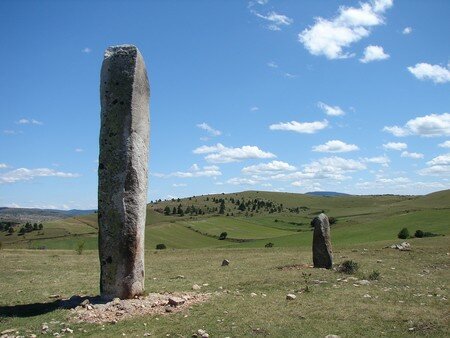 The
group of Vaissière presents the largest menhirs of Cham of the Bungs.
Located at the south of the quasi-abandoned hamlets of Vaissière and
Fare, it is a unit numerically very important (forty menhirs) but also
very spread out over the ground.
The
group of Vaissière presents the largest menhirs of Cham of the Bungs.
Located at the south of the quasi-abandoned hamlets of Vaissière and
Fare, it is a unit numerically very important (forty menhirs) but also
very spread out over the ground.
 It
is this group which profited the most from the last restorations, which
A made it possible to re-examine set up in majesty of very large
monoliths bordering the 5 meters height. While trotting oneself in this
group, one still notices nearly ten stones lying, stones which should
be replanted in the months or the years to come.
It
is this group which profited the most from the last restorations, which
A made it possible to re-examine set up in majesty of very large
monoliths bordering the 5 meters height. While trotting oneself in this
group, one still notices nearly ten stones lying, stones which should
be replanted in the months or the years to come.
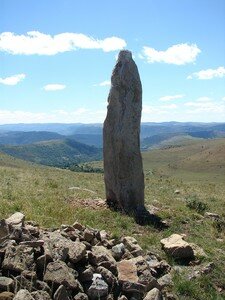 Very
near to the group of Vaissière but separated by a deep ravine, the
group of Colobrières is easy to reach in half an hour of walk. The
interest comes especially from the beautiful menhir of Colobrières high
of almost 4 meters and planted in top of a croup. The other menhirs
neighbourhood are always lying and of lower size.
Very
near to the group of Vaissière but separated by a deep ravine, the
group of Colobrières is easy to reach in half an hour of walk. The
interest comes especially from the beautiful menhir of Colobrières high
of almost 4 meters and planted in top of a croup. The other menhirs
neighbourhood are always lying and of lower size.
I was going to forget my small pal…

/https%3A%2F%2Fprofilepics.canalblog.com%2Fprofilepics%2F1%2F1%2F116167.jpg)
/https%3A%2F%2Fstorage.canalblog.com%2F49%2F16%2F312499%2F14620054_o.jpg)
/https%3A%2F%2Fstorage.canalblog.com%2F53%2F18%2F312499%2F14151229_o.jpg)
/https%3A%2F%2Fstorage.canalblog.com%2F07%2F05%2F312499%2F14149867_o.jpg)
/https%3A%2F%2Fstorage.canalblog.com%2F11%2F35%2F312499%2F14149307_o.jpg)
/https%3A%2F%2Fstorage.canalblog.com%2F90%2F14%2F312499%2F14125247_o.jpg)

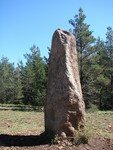

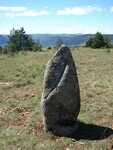
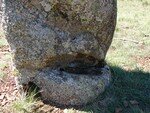








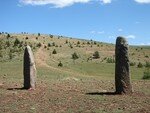


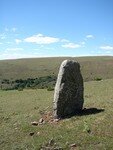

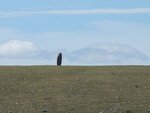
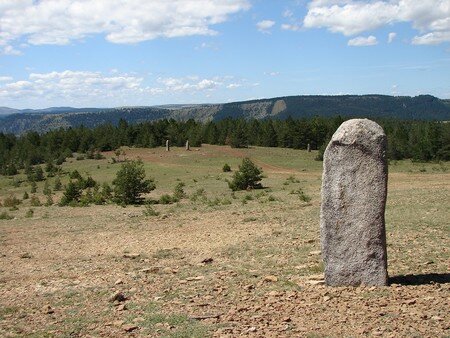



/https%3A%2F%2Fstorage.canalblog.com%2F12%2F98%2F137895%2F6624411_p.jpg)
/https%3A%2F%2Fstorage.canalblog.com%2F34%2F82%2F137895%2F27207854_p.jpg)
/https%3A%2F%2Fstorage.canalblog.com%2F32%2F37%2F137895%2F15872299_p.jpg)
/https%3A%2F%2Fstorage.canalblog.com%2F37%2F81%2F137895%2F15879822_p.jpg)